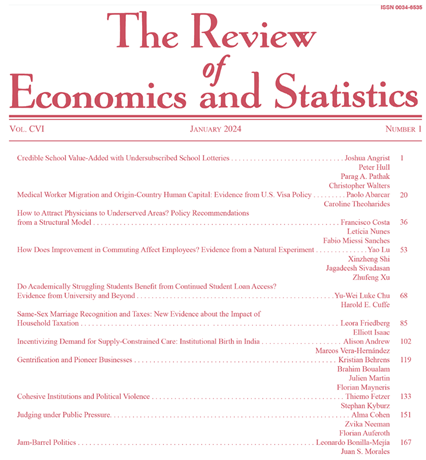Assessment of The Effectiveness of Fiscal Policy in The Context of Socio-Economic Interests
IF 7.6
1区 经济学
Q1 ECONOMICS
引用次数: 0
Abstract
Purpose of the study. The purpose of the study is to propose a conceptual approach to assessing the effectiveness of fiscal policy in the context of socio-economic interests based on the identification of the position of the state not only as a tax recipient, but also as a regulator of economic activity. In accordance with the goal, the following tasks are set: 1) within the framework of a conceptual approach to assessing the effectiveness of fiscal policy in the context of the socio-economic interests of the approach, to propose a mathematical interpretation of the target function of taxes paid by an economic entity - taxpayer and the target function of tax revenues to the state; 2) justify the functional limitations of these objective functions and propose a logic for justifying the parameters of the Laffer curve; 3) propose an approach to explaining the shape of the Laffer curve, due to the rotation of the parabola on the axis of penalties; 4) to confirm the proposed approach, on the basis of correlation analysis, evaluate the closeness of the relationship between the level of the tax burden, the number of on-site audits and the amount of additionally assessed funds for an on-site tax audit.Materials and methods. The article uses information from the scientific works of Russian and foreign scientists, Internet resources. The following methods were used in the work: the method of logical analysis (for the logical substantiation of the parameters of the Laffer curve); correlation analysis (to identify the relationship between the level of the tax burden, the number of on-site audits and the amount of additionally assessed funds for an on-site tax audit); the assessment of the tightness of the connection was checked according to the Chaddock scale; graphical method (to reflect different approaches to constructing the Laffer curve).Results. The paper proposes a conceptual approach to assessing the effectiveness of fiscal policy in the context of socio-economic interests, which involves highlighting the position of the state not only as a tax recipient, but also as a regulator of economic activity. Within the framework of this approach, a mathematical interpretation of the target function of taxes paid by an economic entity - a taxpayer and the target function of tax revenues to the state are proposed. The functional limitations of these objective functions are substantiated and the logic of justifying the parameters of the Laffer curve is proposed. Various approaches to the construction of the Laffer curve are considered. The arguments of critics of the Laffer curve are analyzed. An approach is proposed to explain the shape of the Laffer curve due to the rotation of the parabola on the penalty axis. The logic of substantiation of the parameters of the Laffer curve is determined. Based on the correlation analysis, the tightness of the relationship between the level of the tax burden, the number of on-site audits and the amount of additionally charged funds for an on-site tax audit was estimated. A trend towards a decrease in the number of on-site inspections (as a form of tax control) is revealed, while maintaining the main fiscal task of increasing revenues to the budget of the Russian Federation.Conclusion. The proposed conceptual approach to assessing the effectiveness of fiscal policy in the context of socio-economic interests makes it possible to separate the assessment of fiscal efficiency and macroeconomic efficiency of fiscal policy and be guided by the proposed parameters when determining tax rates, which will allow using the fiscal policy of the state as an element of harmonizing the socio-economic interests of society.社会经济利益背景下的财政政策有效性评价
研究目的:本研究的目的是提出一种概念性方法,在社会经济利益背景下评估财政政策的有效性,该方法基于对国家不仅作为税收接受者,而且作为经济活动的监管者的定位。根据目标,设置了以下任务:1)在评估财政政策有效性的概念方法框架内,在该方法的社会经济利益背景下,对经济实体-纳税人支付的税收目标函数和国家税收收入的目标函数提出数学解释;2)对这些目标函数的功能局限性进行了论证,提出了对拉弗曲线参数进行论证的逻辑;3)提出了一种解释拉弗曲线形状的方法,由于罚球轴上抛物线的旋转;4)在相关分析的基础上,对税收负担水平、现场审计次数和现场税务审计追加评估资金数额之间的密切关系进行验证。材料和方法。本文使用的信息来自俄罗斯和外国科学家的科学著作,互联网资源。工作中采用了以下方法:逻辑分析法(对拉弗曲线的参数进行逻辑论证);相关性分析(确定税负水平、现场审计次数和现场税务审计额外评估资金数额之间的关系);按照Chaddock量表对接头的松紧度进行考核;图形方法(反映构造拉弗曲线的不同方法)。结果。本文提出了一种在社会经济利益背景下评估财政政策有效性的概念性方法,其中包括强调国家不仅作为税收接受者,而且作为经济活动的监管者的地位。在这种方法的框架内,提出了经济实体(纳税人)纳税目标函数和国家税收目标函数的数学解释。证明了这些目标函数的功能局限性,并提出了拉弗曲线参数的合理化逻辑。考虑了构造拉弗曲线的各种方法。分析了拉弗曲线批评者的论点。提出了一种方法来解释由于抛物线在罚轴上的旋转而引起的拉弗曲线的形状。确定了拉弗曲线参数的实化逻辑。通过相关分析,估计了税负水平、现场稽查次数和现场稽查附加费用之间的密切关系。现场视察次数(作为税收控制的一种形式)有减少的趋势,同时保持增加俄罗斯联邦预算收入的主要财政任务。在社会经济利益背景下评估财政政策有效性的拟议概念性方法使得将财政政策的财政效率评估与财政政策的宏观经济效率评估分开成为可能,并在确定税率时以拟议参数为指导,这将允许使用国家财政政策作为协调社会社会经济利益的要素。
本文章由计算机程序翻译,如有差异,请以英文原文为准。
求助全文
约1分钟内获得全文
求助全文
来源期刊

Review of Economics and Statistics
Multiple-
CiteScore
8.50
自引率
0.00%
发文量
175
期刊介绍:
The Review of Economics and Statistics is a 100-year-old general journal of applied (especially quantitative) economics. Edited at the Harvard Kennedy School, the Review has published some of the most important articles in empirical economics.
 求助内容:
求助内容: 应助结果提醒方式:
应助结果提醒方式:


